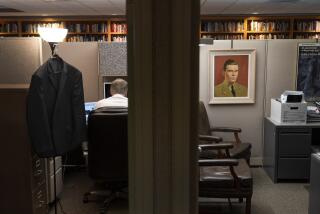It’s Time to Bench ‘Team B’
- Share via
The reports of the Sept. 11 commission and the Senate Select Committee on Intelligence missed the real problem facing the intelligence community, which is not organization or culture but something known as the “Team B” concept. And the real villains are the hard-liners who created the concept out of an unwillingness to accept the unbiased and balanced judgments of intelligence professionals.
The roots of the problem go back to May 6, 1976, when the director of Central Intelligence, George H.W. Bush, created the first Team B to assess a report his agency had done on Soviet strategic objectives. The report -- a National Intelligence Estimate, or NIE, completed the previous year -- did not endorse a worst-case scenario of Soviet capabilities and, as a result, some outsiders demanded access to the same classified intelligence used by the CIA in preparing it so that they could come to their own conclusions.
The concept of a “competitive analysis” of the data done by an alternative team had been opposed by William Colby, Bush’s predecessor as CIA director and a career professional. But Bush caved in, under pressure from President Ford, who was facing a strong challenge from right-wing Republicans in that year’s presidential primary, as well as from then-Secretary of Defense Donald Rumsfeld’s Pentagon, which was trying to undermine support for Henry Kissinger’s detente with the Soviet Union.
The outside experts on Team B were led by Harvard professor Richard Pipes and included such well-known Cold War hawks as Paul Nitze, William Van Cleave and Paul Wolfowitz. Not surprisingly, Team B concluded that the intelligence specialists had badly underestimated the threat by relying too heavily on hard data instead of extrapolating Soviet intentions from ideology.
The Team B report was enthusiastically received by conservative groups such as the Committee on the Present Danger. But it turned out to be grossly inaccurate. For example, it said the Soviets would have 500 intercontinental Backfire bombers capable of striking the United States by 1984. In reality, only 235 were deployed by then. Team B also claimed that the Soviets were working on a “stealthy” submarine, though it failed to find any evidence of one.
Team B was right about one thing. The CIA estimate was indeed flawed. But it was flawed in the other direction. In 1978, the Senate Select Committee on Intelligence concluded that the selection of Team B members had yielded a flawed composition of political views and biases. And a 1989 review concluded that the Soviet threat had been substantially overestimated in the CIA’s annual intelligence estimates.
Still, the failure of Team B in 1976 did not deter the hard-liners from challenging the CIA’s judgments for the next three decades. In 1981, after the publication of Clare Sterling’s book, “The Terror Network,” which argued that global terrorists were actually pawns of the Soviets, leading hard-liners asked the CIA to look into the relationship between Soviets and terrorist organizations. The agency concluded that although there was evidence that the Soviets had assisted groups such as the Palestine Liberation Organization with weapons and training, there was no evidence that the Soviets encouraged or approved these groups’ terrorist acts. However, hard-liners like Secretary of State Alexander Haig, CIA Chief William Casey and Policy Planning Director Wolfowitz rejected the draft as a naive, exculpatory brief and had the draft retooled to assert that the Soviets were heavily involved in supporting “revolutionary violence worldwide.”
During the Clinton years, the Team B hard-liners found themselves out of power. But when the Republicans took control of the Congress in 1995, the legislative branch became the favored vehicle for second-guessing the CIA. When an NIE in the mid-1990s concluded that it would be at least 15 years before a rogue nation could threaten the U.S. with an intercontinental ballistic missile, it undercut the hard-liners’ case for deploying a national missile defense system. So the Republicans demanded that Congress set up a commission headed by Rumsfeld to reassess the threat.
It is no secret now that Douglas Feith, George W. Bush’s undersecretary of Defense for policy, set up his own intelligence operation in the Pentagon, known as the Office of Special Plans. According to current and former Pentagon officials, Feith believed that the CIA and other intelligence agencies dangerously underestimated threats to U.S. interests.
To be sure, the intelligence community has made misjudgments. That is to be expected. But given all the second-guessing and political pressure and public embarrassment it has faced in the past when it tried to present unbiased objective assessments of threats from the Soviets, China, and rogue nations, it is not surprising that the intelligence community ultimately caved in on whether Iraq had weapons of mass destruction.
Creating an intelligence czar, as recommended by the Sept. 11 commission, may help. But unless we protect the professionalism of our analysts, not much will change.
Lawrence Korb is a senior fellow at the Center for American Progress and former assistant secretary of Defense in the Reagan administration.
More to Read
Sign up for Essential California
The most important California stories and recommendations in your inbox every morning.
You may occasionally receive promotional content from the Los Angeles Times.










